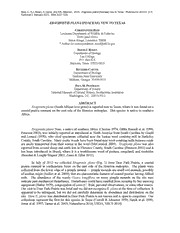Table Of ContentReid, C, D.J. Rosen, R. Carter, and RM. Peterson. 2015. Eragrostis plana {Po^^€} new to Texas. Phytoneuron 2015-5: 1-3.
Published 1 February 2015. ISSN 2153 733X
NEW
ERAGROSTIS PLANA (POACEAE) TO TEXAS
Christopher Reid
&
Louisiana Department of Wildlife Fisheries
2000 Quail Drive
Baton Rouge, Louisiana 70808
* Author for correspondence: [email protected]
David Rosen
J.
Department of Biology
Lee College
Box
P.O. 818
Baytown, Texas 77522-0818
Richard Carter
Department of Biology
Valdosta State University
Valdosta, Georgia 31698-0015
Paul M.Peterson
Department of Botany
Museum
National of Natural History Smithsonian Institution
Washington, DC. 20013-7012
ABSTRACT
Eragmstis plana (South African love grass) reported new to Texas, where was found on a
is it
coastal prairie remnant on the east side of the Houston metroplex. This species native to southern
is
Africa.
Eragmstis plana Nees, a native of southern Africa (Clayton 1974; Gibbs Russell et al. 1990;
Peterson 2003), was initially reported as introduced in North America from South Carolina by Gould
and Lonard (1970), who cited specimens collected near the Santee wool combing mill in Berkeley
Many
County, South Carolina. exotic weeds have been found near wool combing mills because seeds
are easily transported from their source in the wool (McCormick 2005). Eragmstis plana was also
reported from around sheep and cattle lots in Florence County, South Carolina (Peterson 2003) and
it
has been introduced in Brazil, where a troublesome weed of pasture, rangeland, and roadsides
it is
& &
(Boechat Longhi-Wagner 2001; Zenni Ziller 2011).
we
In July of 2012 collected Eragrostis plana (Fig. from Deer Park Prairie, a coastal
1)
prairie remnant in southeastern Texas on the east side of the Houston metroplex. The plants were
—
collected from the lower edge of a pimple mound pimple mounds are small soil mounds, possibly
of aeolian origin (Seifert et al. 2009), that are characteristic features of coastal prairies having Alfisol
soils. The abundance of the weedy Gaura longiflora on many pimple mounds on the site may
indicate past mechanical disturbance. Disturbance could have resulted from scraping by hay mowing
equipment (Butler 1979), congregation of cows (C. Reid, personal observation), or some other source
Our visit to Deer Park Prairie was brief and we did not recognize E. plana at the time of collection. It
we
appeared to be infrequent, but did not carefully determine abundance and distribution on the
its
How
E. plana was distributed to Deer Park Prairie not known and open to conjecture Our
site. is is
&
collections represent the first for this species in Texas (Correll Johnston 1970; Hatch et al. 1990;
USDA, NRCS
Jones et al. 1997; Turner et al. 2003; NatureServe 2014; 2014).
m
Reid et al.: Eragrostis plana Texas 2
Figure Eragrostis plana collected from Deer Park Prairie in soufrieastem Texas in July 2012.
1.
Reid et al.: Eragrostis plana\v\ Texas 3
USA.
Voucher specimens Texas. Harris Co. Small (ca. 50-acre) coastal prairie reitmant in
: :
km NE Hwy
the town of Deer Park, about 0.5 of the intersection of Spencer and Luella Ave.,
29.671156 N, -95.108034 W, infrequent in a very rich native plant community dominated by
Paspalum piicatuium, Schizachyrium scoparium, Muhienbergia capillar and Sporoholus spartinm
is,
[=Spartina spartinae], 21 Jul 2012, D.J. Rosen 5763 with Carter and Reid (BRIT, TEX, US), C. Reid
8143 with Carter and Rosen (LSU).
ACKNOWLEDGEMENT
We
thank Flo Haimah with Houston Audubon Society for arranging access to Deer Park
Prairie.
LITERATURE CITED
O
Boechat, S.C. and H.M. Longhi-Wagner. 2001. genero SragrorfK (Poaceae) no Brasil. Iheringia,
Bot. 55: 23-169.
AC. Mima mound
Butler, 1979. grasslands of the upper coastal prairie of Texas. M.S. thesis. Texas
M
A &
University, College Station.
WD.
Clayton, 1974. 56. Eragrostis. Pp. 188-244 in R.M. Polhill (ed.). Gramineae (Part 2), Flora
of Tropical East Africa. Crown Agents for Oversea Governments and Administrations,
London.
Correll, D.S. and M.C. Johnston. 1970. Manual of the Vascular Plants of Texas. Texas Research
Foundation, Renner.
Gibbs Russell, G.E., L. Watson, M. Koekemoer, L. Smook, N.P Barker, H.M. Anderson, and M.J.
Dallwitz. 1991. Grasses of southern Africa. Mem. Bot. Surv. South Africa 58: 1^37.
FW.
Gould, and R.I. Lonard. 1970. Sragroxtep/ana in South Carolina. Rhodora 72: 188.
Brown
Hatch, S.L., K.N. Gandhi, and L.E. 1990. Checklist of the Vascular Plants of Texas. Texas
Agric. Exp. Sta. Bull. MP-1655.
A
Jones, S.D., J.K Wipflf, and PM. Montgomery 1997. Vascular Plants of Texas: Comprehensive
Checklist Including Synonymy, Bibliography, and Index. Univ. of Texas Press, Austin.
CA
McCormick, 2005. Wool-gathering in the herbarium. North Carolina Botanical Garden
Newsletter, September-October 2005.
An
NatureServe 2014. NatureServe Explorer: online encyclopedia of Version NatureServe,
life. 7. 1.
Arlington, Virginia, <http://www.natureserve.org/explorer>
Peterson, P.M. 2003. SragrorfK (Poaceae). Pp. 65-105, in Flora of North America North of Mexico.
New
Vol. 25, part 2. Oxford Univ Press, York and Oxford.
A
Seifert, C.L., R.T Cox, S.L. Forman, TL. Foti, T. Wasklewicz, and AT. McColgan. 2009. Rehct
nebkhas (pimple mounds) record prolonged late Holocene drought in the forested region of
south-central United States. Quaternary Res. 71: 329-339.
Turner, B.L., H. Nichols, G. Denny, O. Doron. 2003. Atlas of the Vascular Plants of Texas. Volume
Sida Bot Miscell. 24: 1-648.
1.
USDA, NRCS. 2014. The PLANTS Database. National Plant Data Team, Greensboro, North
Carolina, <http://plants.usda.gov> Accessed November 2014.
An Bot
Zenni, R.D. and S.R. Ziller. 2011. overview of invasive plants of Brazil. Revista Brasil. 34:
431-446.

